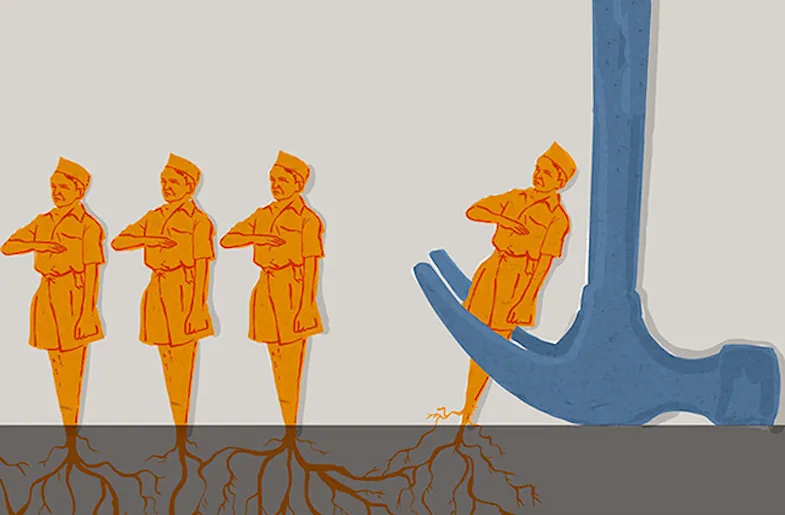An Assessment of Anti-Hindu Sentiments in the Digital Era
Image Courtesy: Swarajya Magazine
Introduction
In this digital age, social media platforms have become crucibles for the expression of diverse viewpoints, including those about religious beliefs. Hinduism, with its deep historical roots and widespread practices, has increasingly become the subject of intense scrutiny and criticism online. This surge in online scrutiny offers an opportunity to explore and understand the challenges faced by Hinduism in modern times, particularly in the form of criticism and misconceptions.
The Legacy of Colonial Misrepresentation
The historical context of Hinduism under colonial rule laid the foundation for many of the misconceptions prevalent today. British imperialism often sought to diminish the stature of Hinduism to establish cultural and political dominance. This legacy of misrepresentation has propagated enduring stereotypes and necessitates a re-evaluation of Hinduism’s portrayal, particularly in the context of its philosophical depth and cultural richness.
Hindutva: A Political Response in Defense of Hinduism
Hindutva, often at the center of digital controversies, represents not a divergence from Hinduism but a political response aimed at protecting its ethos against misrepresentation and external threats. This ideology, stemming from a place of preservation, is frequently misunderstood in digital discourse, leading to its portrayal as an exclusivist or aggressive force. In reality, Hindutva emerges from a need to safeguard the pluralistic and tolerant nature of Hinduism in the face of challenges posed by global cultural and political shifts. Understanding this context is crucial to dispel the myths surrounding it and to appreciate its role in the socio-political landscape of modern Hinduism.
Caste Narrative: Addressing Discrimination and Confronting Misconceptions
The caste system, often a focal point of criticism, must be understood within the broader narrative of Hinduism’s evolution. While it has been a source of social inequality, Hinduism has also been home to continuous reform movements advocating for social justice, equality, and the dismantling of oppressive structures. These efforts reflect the religion’s inherent capacity for self-reflection and change, often overlooked in digital critiques.
However, it’s crucial to address the “elephant in the room” – the toxic hate and vilification directed at certain castes, particularly Brahmins, in the name of caste activism. While caste discrimination remains a reality and needs addressing, the narrative often turns into one of hate and generalization against specific communities within Hinduism. This aspect of the caste debate requires a balanced and nuanced approach, acknowledging the reality of caste discrimination while condemning hate speech and generalized vilification.
Cultural Practices and Selective Environmental Concerns
The criticism of Hindu festivals like Deepavali, often cited for environmental concerns, particularly air pollution, needs a more nuanced perspective. While these celebrations do involve fireworks, they are typically limited to a single day, and the broader issue of pollution often stems from continuous factors in neighboring regions. This selective scrutiny, compared to the less critical view of similar practices in other religions, suggests an imbalance in how religious traditions are evaluated for their environmental impacts. A more equitable approach, acknowledging the true sources of environmental issues and respecting the cultural significance of these traditions, is essential for a balanced and informed discourse.
Media Influence and Digital Narratives
The media’s portrayal of Hinduism significantly influences public opinion, often framing the narrative that shapes perceptions globally. In the digital realm, platforms can inadvertently serve as echo chambers, amplifying extremist views and misinformation, particularly about aspects like Hindutva. This not only distorts the public’s understanding but can also foster unwarranted fear and bias. The prevalence of such skewed narratives necessitates a commitment to responsible journalism and diligent content moderation. This approach should aim to present a balanced view, encompassing the rich diversity and philosophical depth of Hinduism. Moreover, it’s imperative for media platforms to actively counter misinformation by providing contextual and accurate information, thereby promoting a more informed and fair discourse about Hinduism in the public sphere.
Promoting Pluralism and Understanding
Combating misconceptions and hate about Hinduism requires a multi-faceted approach that emphasizes promoting pluralism and fostering a deeper understanding of the religion’s diverse practices and philosophies. Continued initiatives that encourage interfaith dialogue, educational outreach, and media literacy play a vital role in dispelling myths and broadening the public’s perspective on Hinduism. Such efforts not only clarify misunderstandings but also highlight the rich tapestry of narratives and teachings within Hinduism. Additionally, incorporating perspectives from a wide range of Hindu traditions and practices in educational and media content can further enrich the public discourse. By nurturing a more inclusive view of Hinduism, these initiatives contribute significantly to building a society that values diversity, encourages mutual respect, and embraces the varied expressions of faith and spirituality. This inclusive approach can bridge gaps in understanding and foster a shared sense of humanity, transcending religious and cultural divides.
Conclusion
Understanding anti-Hindu sentiments in the digital era requires a nuanced approach that considers the historical, cultural, and political dimensions of Hinduism. Recognizing Hindutva as a protective response to Hinduism’s defense and not as an exclusionary ideology is essential in this reassessment. As we navigate through these complex narratives, fostering informed, respectful, and empathetic dialogues is imperative. Such an approach ensures Hinduism’s diverse and profound legacy is accurately represented and appreciated in the global conversation, contributing to a more nuanced and balanced understanding of one of the world’s most ancient and multifaceted religious traditions.
This article is based on hindumisia.ai’s The Global Anti-Hindu Annual Report for 2022

